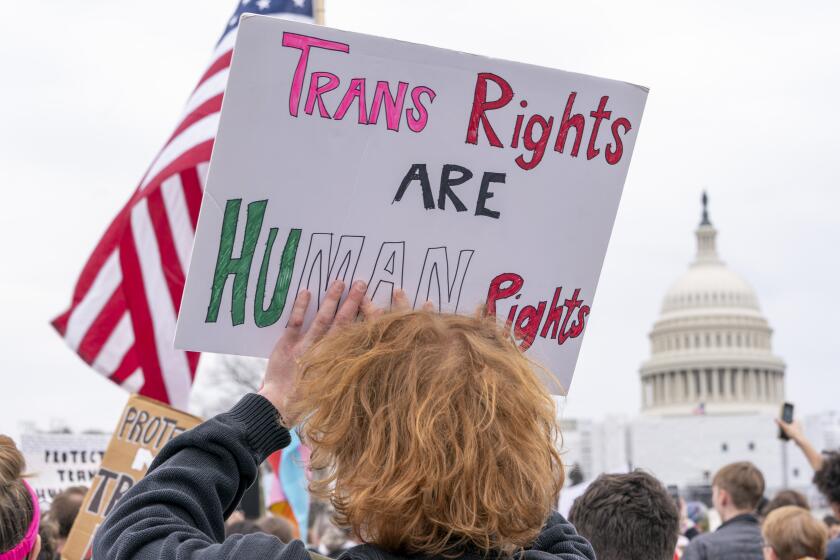Opposing Views of U.S. Economy Are Worthy Debate Fodder for 2000 Election
- Share via
Last week’s observance of Labor Day brought with it the annual media coverage of the state of labor in the United States, a subject nearly ignored the rest of the year. Except for Labor Day, workers are typically treated as an abstract factor of production, a price for employers and as wage statistics that might affect Wall Street or the musings of Alan Greenspan.
But even last week’s coverage of the state of labor in the U.S. tended to avoid the obvious: The new high-tech economy is splitting the country into several segments, not only between “haves and have-nots,” but between two entirely different views on the underlying benefits of the U.S. economy, a phenomenon that could have a profound impact on next year’s national elections.
Here’s one point of view: Not only is the U.S. economy in great shape, it’s the envy of the world.
High-tech is the engine of what is only five months shy of being the longest economic expansion in U.S. history. The stock market is at record levels. The federal government has a budget surplus. Unemployment is at a 30-year low. Inflation is almost nonexistent. Crime is down, cities are rebounding, the poor are going back to work and even income inequality appears to be softening.
Here’s the other view: Median family incomes for the middle-class haven’t budged, after adjusting for inflation, in 10 years.
The majority of workers, especially young to middle-aged men, are making less now in hourly wages than 20 years ago. Nearly every family requires two wage earners to preserve the family’s financial status quo, and Americans are working longer hours than others in the industrialized world.
Americans also are running up record levels of debt, especially with credit cards. The United States’ foreign trade deficit has grown faster than stock market prices. At a time of unprecedented national wealth, more than a quarter of the nation’s children live in poverty.
“What is the purpose of an economy?” asks Professor Robert Brenner, Director of UCLA’s Center for Social Theory and Comparative History and author of the soon-to-be-published “Turbulence in the World Economy” (Verso Books, 1999). “What are the criteria for whether an economy is doing well or not doing well?”
Those are the kinds of questions Americans might ask political candidates next year.
A debate is emerging among economists, academics and economic observers about what explains the very mixed performance of the U.S. economy. At the center of this debate is whether productivity is going up, why it has been so low in the last decade, and whether technology is really contributing to Americans’ standard of living.
Brenner notes that during the last decade, with the exception of the U.S. manufacturing sector, U.S. productivity growth has been the worst in its history, half or even less than half the average rate of growth for the previous 100 years.
He blames this on the strategy of U.S. corporations that took advantage of low wages and a strong dollar, factors that depressed the need to invest in productivity-enhancing technologies. If it’s cheap to do work with labor, Brenner argues, there is less pressure to invest in greater productivity.
The question on the table is whether productivity can be stimulated and bring with it higher wages, or whether companies will continue to take profits at the expense of wages and leave most American families stuck where they are.
One answer might be trade unions. “Strengthening unions would raise wages and productivity,” Brenner says. Trade unions would appear to be the solution for a lot of problems facing American workers, such as longer hours, fewer benefits and stagnant wages. The same problems created unions a hundred years ago.
In fact, more Americans are sympathetic to unions than in the recent past, especially younger workers, according to recent surveys commissioned by the AFL-CIO.
In a survey of nonunion workers in nonsupervisory roles, 43% said they would vote yes for a union, up from 30% in 1984. A majority of workers--54% between the ages of 18 and 34--said they would choose to join a union, the AFL-CIO survey reported.
These figures, if accurate, are portentous, but especially in contrast to attitudes about trade unions in the affluent high-tech sector. There, the subject of unions is treated with nearly unanimous contempt and even anger, a feature of the individualist, libertarian ethos that permeates the ranks of highly skilled and well-paid technical workers.
Thus, we’re seeing a deep and fundamental split among workers under age 40--between the millions who don’t have a college education and the small elite that Wired magazine labeled “Generation Equity” who are living on stock options, paper wealth and profit-taking from the stock market.
This disparity could shape next year’s election debates. Al Gore was a high-tech candidate in 1992 and 1996, when many Republican high-tech executives supported the Clinton-Gore ticket. Now younger and richer high-tech leaders view Gore as ominously close to the AFL-CIO and its agenda. As a supporter of both high-tech and unions, Gore is trying to have it both ways, but that may be impossible.
The historical pattern of how technology has affected the economy should teach us that technology has no “natural” logic of its own, as some high-tech leaders claim. It is always an expression of economic relations. High-tech could be used in different ways to benefit more people than it does.
How can we get our political candidates to talk about that?
*
Gary Chapman is director of the 21st Century Project at the University of Texas at Austin. He can be reached at gary.chapman@mail.utexas.edu.
More to Read
Get the L.A. Times Politics newsletter
Deeply reported insights into legislation, politics and policy from Sacramento, Washington and beyond. In your inbox twice per week.
You may occasionally receive promotional content from the Los Angeles Times.










